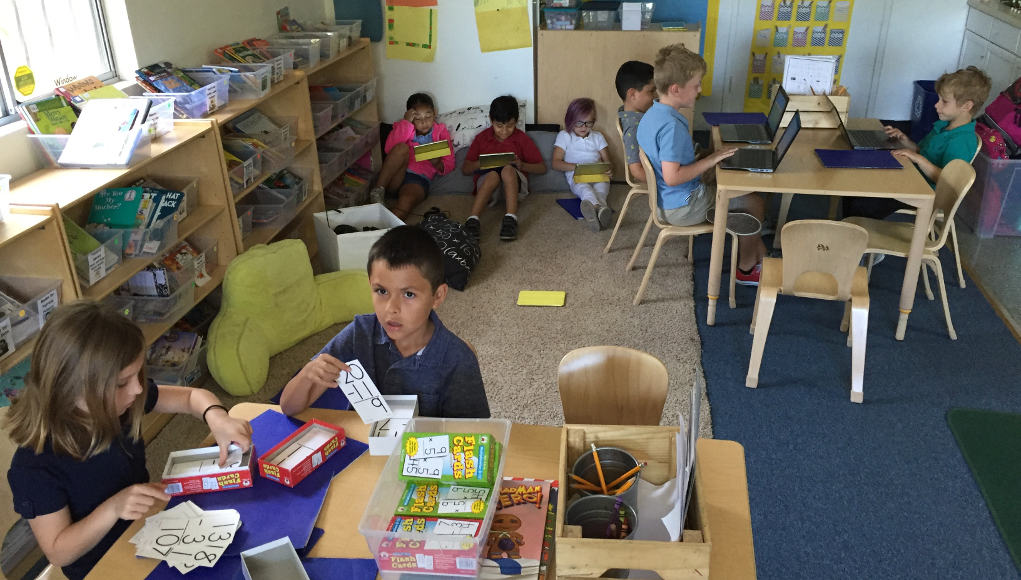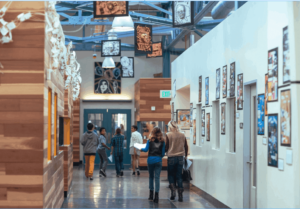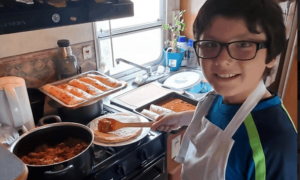Little Kids, Big Ideas: Inspiring Project-Based Learning

By Nicole Assisi and Jamie Little
This blog originally ran on EdWeek.
Third and fourth graders flood the auditorium stage, dancing passionately in a complex modern dance performance, every child moving with purpose and confidence.
First graders pull out the stitches on the stuffed animals they are making for children in the community affected by cancer, committed to getting the final product just right.
A boy on the autism spectrum, typically introverted and removed from the action of the classroom, lights up the stage as the emcee of a six-part theater performance.
 This is the power of project-based learning. Projects done well can reveal children’s hidden talents and hidden genius, both to their teachers and even to the children themselves. They connect students to their communities and help them envision the many ways they can contribute to the world and have an impact on real people.
This is the power of project-based learning. Projects done well can reveal children’s hidden talents and hidden genius, both to their teachers and even to the children themselves. They connect students to their communities and help them envision the many ways they can contribute to the world and have an impact on real people.
But project-based learning can be intimidating. Those students making stuffed animals first investigated the neuroscience of touch–new content for both the students and their teacher. A teacher engaging in a new project is often just a few steps ahead of her students, gathering the content knowledge necessary to produce a meaningful final product. And it can be hard to know where to start–how do you figure out where your students will really make an impact? What projects will inspire and motivate them to create beautiful work?
These are perennial questions for teachers engaged in project-based learning. At Thrive, we have found that the following practices help our teachers to answer these questions and do incredible, meaningful work with even our smallest learners:
1. Explore your community. Educator and author Ron Berger emphasizes how project work must have an authentic audience in order to be meaningful and engaging. To identify powerful audiences for our students’ work, Thrive staff devotes time to developing a bird’s-eye view of our local community.
Our teachers take part in many activities to develop this view. One of our expert teachers leads her colleagues in creating community resource maps. We watch a brief video to identify broader themes in history that could connect to our students. We reach out to families, both for connections to outside organizations and experts, and for ideas of work and service that our students could be passionate about. We ask our students to interview others about problems they would like to see solved in daily life or in the larger world.
The search for project ideas is a constant in our staff development. We regularly bring in articles about successful projects and project ideas, keep our eyes open for places in our community where we could be of service, and support each other in strengthening projects with additional connections from our personal and professional networks.
 Projects that lay the groundwork for a true connection between students and their community can lead to powerful experiences. When K-1 teacher Jaclyn Vasko wanted to partner with a senior center, she reached out only to places within walking distance of her campus.
Projects that lay the groundwork for a true connection between students and their community can lead to powerful experiences. When K-1 teacher Jaclyn Vasko wanted to partner with a senior center, she reached out only to places within walking distance of her campus.
“I really wanted the kids to have a connection that was long-lasting,” Vasko said. With the senior center she ultimately located, the class “could walk there on a Tuesday for an hour, have lunch with them, and come back. Even when we would drive by or kids would drive by, they could stop at the senior center or go in with their family.” Students built meaningful relationships because they had regular and informal access to the center.
2. Rely on an expert. Great projects often involve content that is new to the teacher as well as the students, and products that have unique real-world requirements. To do the work well, you need an expert. Experts can support teachers with specialized content, from engineering to woodworking. Experts should also be involved from the start in explaining the criteria of the discipline and giving feedback on a product prototype, ensuring that the final product will be beautiful, meaningful, and useful in the real world.
 Where do teachers find all these experts? We have been happily surprised at how many expert connections we have been able to make once we started asking. Our weekly staff meeting often includes teachers explaining their latest work and asking for connections–this once led to twelve engineers visiting a single class! Our administrators make connections for teachers seeking experts during regular coaching sessions. There is a wealth of knowledge in every community once you start looking for it.
Where do teachers find all these experts? We have been happily surprised at how many expert connections we have been able to make once we started asking. Our weekly staff meeting often includes teachers explaining their latest work and asking for connections–this once led to twelve engineers visiting a single class! Our administrators make connections for teachers seeking experts during regular coaching sessions. There is a wealth of knowledge in every community once you start looking for it.
We have also found that experts with a personal connection to our staff members or families are more likely to stay involved through an entire project and even come back the following year, so working your school’s network becomes well worth the effort.
3. Clearly identify your final product. When you start planning a project and reaching out for support, you can get an overwhelming amount of resources: books, lesson plans, ideas, activities and more. It’s critical to stay focused on what you are creating and who your final product will serve.
 For example, one fourth-grade team at Thrive identified an interest among students to learn real-world skills. They were excited to teach their students home economics and their students were excited, too. We pushed them to look back at the framing questions:
For example, one fourth-grade team at Thrive identified an interest among students to learn real-world skills. They were excited to teach their students home economics and their students were excited, too. We pushed them to look back at the framing questions:
- What is the problem you are trying to solve in our broader community?
- Who does this matter to and why?
- What product will help them?
After much reflection and discussion, the team realized the problem was that youth were leaving for college without these basic and critical skills, and so the project could be in service of high school seniors. With an audience in mind, students interviewed actual college students to identify specific skills incoming college freshmen might need.
Students ultimately created a series of YouTube videos targeted at high school seniors teaching life skills like changing tires, using public transportation, doing laundry, and cooking. By staying focused on the final product and its audience, the work moved from “project” to “project-based learning,” with all the learning and making driving toward a final product for a meaningful audience.
We regularly use a version of a tuning protocol during our staff development time to provide feedback to each other on project-based learning plans at multiple stages: first to focus on a final product and audience, later to identify community resources, deepen student work products, and more.
4. Invest in the work. Great projects take resources. Beautiful raw materials lead to more beautiful and professional final products. Time in the classroom for revision after revision leads to more detailed and high-quality work. Teachers need time, too, to try out a project themselves before presenting it to students, to take risks, fail, try again, and grow as a leader of project-based learning. It can take three years of work and reflection for a teacher to excel at this work.
 Schools that are truly investing in project-based learning need to devote the budget and the time for students and teachers to get it right. Teachers pursuing this path themselves must rely on community resources even more, for donations of materials and expertise, as well as give themselves permission to take risks and to fall short of their expectations at first.
Schools that are truly investing in project-based learning need to devote the budget and the time for students and teachers to get it right. Teachers pursuing this path themselves must rely on community resources even more, for donations of materials and expertise, as well as give themselves permission to take risks and to fall short of their expectations at first.
At Thrive, we truly believe that project-based learning is worth the investment. Students gain skills, confidence, and meaning through project-based learning that they don’t experience in other settings. School communities grow stronger, more purposeful, and more connected. Invest in this work, and watch the inspiration take root.
For more, see:
- Getting Smart Podcast | Back to School: A Time to Thrive
- Blended, Project-Based and Social Emotional Learning at Thrive Public Schools
- Project-Based Learning Q&A
Nicole Assisi is the CEO and Co-Founder of Thrive Public Schools. Follow her on Twitter: @DocAssisi
Jamie Little is the Director of Thrive’s 54th Street Campus. Follow her on Twitter: @MsLittleracy
Stay in-the-know with all things EdTech and innovations in learning by signing up to receive the weekly Smart Update.




0 Comments
Leave a Comment
Your email address will not be published. All fields are required.